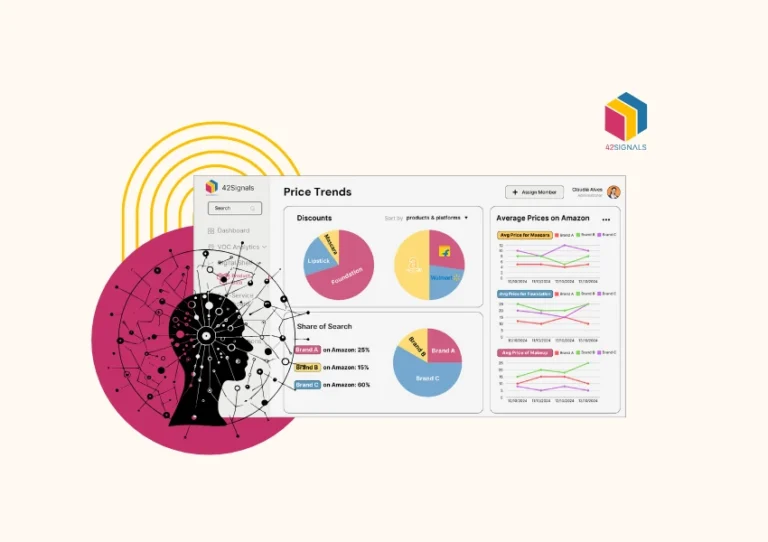With more and more consumers embracing online shopping, retailers realize the crucial importance of optimizing their digital product displays to enrich the overall customer experience and drive sales.
Why is this important? Let’s find out how the digital shelf plays a vital role in shaping the online shopping journey for consumers.
What is an E-commerce Digital Shelf?
Defining the Digital Shelf in Online Retail
The digital shelf is the online representation of a retailer’s products or services, encompassing various elements such as product descriptions, images, search engine visibility, and customer reviews. Much like how physical store shelves are arranged to attract customers, the digital shelf serves as a virtual space where consumers can discover and evaluate products before purchasing.
The Importance of Digital Shelf in the Consumer’s Online Shopping Journey
Customers today rely heavily on the digital shelf to research and compare products before making a buying decision. The digital shelf provides them with the necessary information, visuals, and social proof needed to feel confident about their purchase. As a result, an optimized digital shelf can significantly impact a consumer’s shopping experience, influencing their perception of a brand and ultimately determining whether they proceed with a purchase or abandon the process altogether.
The Components of a Digital Shelf
To fully leverage the potential of the digital shelf, retailers must consider several key components that contribute to its effectiveness. These components are:
1. Product Information Management (PIM)
A robust product information management system is essential for maintaining accurate and up-to-date product information on the digital shelf. This includes details such as product descriptions, specifications, pricing, and availability. Consistency and accuracy across various online channels and platforms are crucial to ensure a seamless customer experience.
2. Search Presence and Optimization
Appearing prominently in search engine results is crucial for products to gain visibility on the digital shelf. Retailers need to implement search engine optimization (SEO) strategies to improve their products’ visibility and increase the chances of being discovered by potential customers.
3. Reviews and Ratings as Shelf Enhancers
Customer reviews and ratings play a vital role in influencing purchase decisions. Retailers should actively encourage customers to leave feedback and reviews on their digital shelves to provide social proof and build trust among potential buyers. Managing and responding to reviews is essential in maintaining a positive brand image.
4. Visual Merchandising in a Virtual Space
Creating visually appealing product displays is crucial for capturing customers’ attention on the digital shelf. High-quality product images, videos, and interactive content contribute to a more engaging shopping experience and can sway consumers toward making a purchase.
What is a Digital Shelf Strategy?
A digital shelf strategy involves a comprehensive plan and approach to optimize the digital shelf components mentioned above. A well-defined strategy helps retailers align their efforts with e-commerce goals and maximize the impact of their online presence. Some key pillars of a robust digital shelf strategy include:

1. Key Pillars of a Robust Digital Shelf Strategy
- Product Data Management: Implementing a centralized system to manage and distribute accurate and consistent product information across all online platforms.
- Content Optimization: Optimizing product descriptions, titles, and metadata to improve search rankings and ensure discoverability.
- Visual Content Enhancement: Enhancing product imagery and videos to create visually compelling digital displays.
- Review Management: Encouraging customers to provide feedback and actively managing reviews to build trust and credibility.
- Competitor Analysis: Monitoring and analyzing competitors’ digital shelf strategies and making necessary adjustments to stay competitive.
2. Aligning Digital Shelf Tactics with E-commerce Goals
It is essential to align digital shelf tactics with broader e-commerce goals to drive desired outcomes. Whether increasing sales, improving customer satisfaction, or expanding reach, each tactic implemented should contribute to the overall e-commerce strategy.
Optimizing for the Digital Shelf
To effectively optimize the digital shelf, retailers must constantly evaluate and adapt their strategies based on emerging trends and changing consumer preferences. Some best practices for optimizing the digital shelf include:
- Continuously updating product information to ensure accuracy and relevance.
- Regularly monitoring and optimizing search keywords and product descriptions.
- Soliciting and responding to customer reviews and ratings.
- Experimenting with different visual merchandising techniques to increase customer engagement.
Challenges in Managing a Digital Shelf
While the digital shelf presents numerous opportunities, there are also challenges that retailers must navigate. Some common challenges include:
1. Keeping Pace with Changing Consumer Preferences
Consumer preferences and behaviors are constantly evolving. Retailers need to stay updated with the latest trends and adapt their digital shelf strategies accordingly to meet changing demands.
2. Ensuring Accuracy and Consistency Across Platforms
Maintaining consistent and accurate product information across multiple online platforms can be challenging. Retailers must invest in robust PIM systems and establish processes to ensure data accuracy and integrity.
3. Combatting Information Overload and Decision Paralysis
With an abundance of choices available on the digital shelf, consumers can easily be overwhelmed, leading to decision paralysis. Retailers should prioritize delivering information that is clear and concise while simplifying the navigation process for consumers on their digital shelves.
Conclusion
Embracing the digital shelf and maintaining a forward-thinking approach in responding to consumer preferences will ultimately pave the way for triumph in the e-commerce landscape.
Recognizing the significance of fine-tuning the digital shelf and putting in place effective strategies, retailers can elevate their online visibility, enhance customer contentment, and stimulate sales.
42Signals empowers brands to achieve success digitally by providing them with the right insights and tools to perform well. Get in touch with us for a free demo at sales@42signals.com





